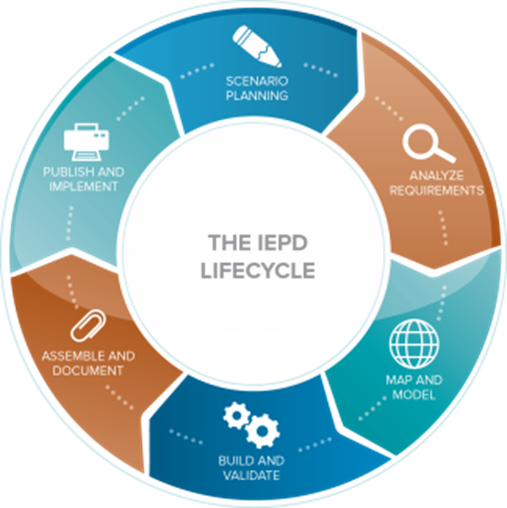IEPD Developer
An Information Exchange Package Documentation (IEPD) Developer designs, builds, and validates the components (artifacts) of an Information Exchange Package (IEP).
The IEPD allows senders and receivers to exchange information in a manner that both understand. The exchange is typically in the form of XML schema documents that define XML instance documents, and other documents that describe, for example, the version history and contents of the documents.
You are here to learn the steps for developing an IEPD according to the IEPD Lifecycle.
IEPD Lifecycle
You develop the IEPD according to a six-phase lifecycle, as shown graphically and listed in the following sections. The phases link to pages with detailed, introductory information about that phase. More lifecycle phase information can be found in the IEPD lifecycle section.

Start with Scenario Planning and work your way through the list in order. See the tutorial for a step-by-step guide to create a simple IEPD set.
-
Scenario Planning: Review background information related to your information exchange, assess resource impact, understand business context, and identify information exchange business scenarios.
-
Analyze Requirements: Further elaborate on the information exchange scenario to understand and document the business context and data requirements.
-
Map and Model: Compare the data requirements for the exchange gathered in the last step to what is available in NIEM. Record results in a mapping spreadsheet and plan how requirements that aren’t available in NIEM should be modeled and added as IEPD extensions.
-
Build and Validate: Create subset and extension schemas for the IEPD based on the mapping and modeling decisions made in the previous step. Check that schemas are valid and NIEM-conformant. Build and validate sample instances for additional testing.
-
Assemble and Document: Finalize the documentation and other IEPD artifacts and then package all related files for the IEPD into a single, self‐contained, self-documented, portable archive file.
-
Publish and Implement: Publish the IEPD for search, discovery, and reuse, and implement the IEPD for production.
IEPD Tutorial
The Simple IEPD tutorial takes you step-by-step through the creation process starting with the Scenario Planning phase. Future tutorials will reference and build from it.
- Simple IEPD - This tutorial shows you how to create a very simple IEPD set. Once you are comfortable with the process and output, you can move on to more complex IEPDs.
IEPD Developer Resources
There are a large number of tools and reference materials available to help you in your development effort. You can see a comprehensive list of information resources at the Reference page. Some of the sections you may find most immediately useful are the ones highlighted below: